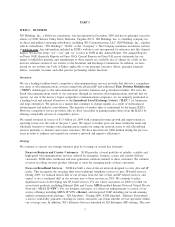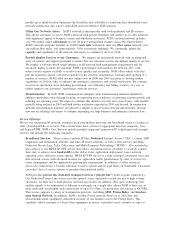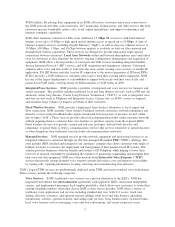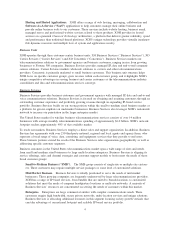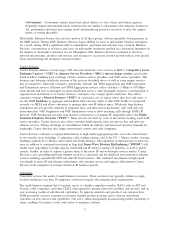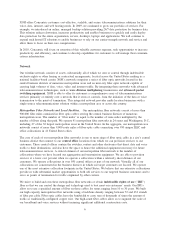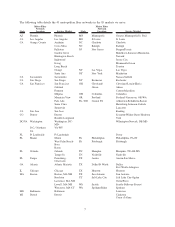XO Communications 2009 Annual Report Download - page 15
Download and view the complete annual report
Please find page 15 of the 2009 XO Communications annual report below. You can navigate through the pages in the report by either clicking on the pages listed below, or by using the keyword search tool below to find specific information within the annual report.Federal Regulation. XOH has authority from the FCC for the installation, acquisition and operation of its
wireline network facilities to provide facilities-based interstate and international telecommunications services.
In addition, XOH is authorized by the FCC to operate its 28 to 31 GHz LMDS and 39 GHz broadband
wireless facilities. Because we are not dominant in any of our markets, unlike ILECs, our telecommunications
services are not subject to price cap or rate of return regulation. Thus, our pricing policies for interstate and
international end user telecommunications services are only subject to the federal requirements that charges
for such services be just, reasonable, and non-discriminatory. The FCC allows us to file interstate tariffs for
our interstate access services (rates charged by us to other carriers for access to our network). As for interstate
and international long distance telecommunications services, the FCC requires us to make the terms, conditions
and rates of the detariffed services available to the public on our web site.
The Telecom Act includes a number of provisions designed to encourage competition in local telephone
service, including requirements related to interconnection; intercarrier compensation; local number portability;
access to poles, conduits, rights of way and resale; as well as specific requirements imposed on ILECs related
to interconnection, collocation, and access to unbundled network elements (“UNE”) available at forward
looking economic costs. As governed by the Telecom Act, CLEC access to ILEC networks and utility poles
are implemented through individually negotiated contracts that conform to applicable FCC rules. Although the
rights established in the Telecom Act are a necessary prerequisite to the introduction of full local competition,
they must be properly implemented and enforced to permit competitive telephone companies like us to
compete effectively with the ILECs. In a series of orders and related court challenges that date back to 1996,
the FCC has put into effect rules implementing the market-opening provisions of the Telecom Act, including
the requirement that the ILECs lease UNEs to competitors at cost-based rates. At the core of the series of
FCC orders is the FCC’s evolving effort to define and list which ILEC network facilities must be made
available as UNEs. Under pressure from the ILECs, the FCC has subsequently reduced the list. However, to
date the FCC has preserved access to those network elements critical to the operation of our business.
FCC Regulation of Wireless Services. XOH is the licensee of authorizations issued by the FCC in LMDS
and 39 GHz services. As an FCC licensee, XOH is subject to regulatory oversight, including limits on the
amount of foreign investment in certain FCC licenses, the transfer and assignment of FCC licenses, and
regulations governing the construction, technical aspects and the nature of services that can be provided by
operators of wireless communications systems. The FCC regulates the use of the electromagnetic spectrum,
and has exclusive jurisdiction over licensing and technical rules governing the operation of wireless services.
The majority of our FCC licenses are in the LMDS spectrum range, which is one of the several FCC-licensed
services that permit licensees and/or their customers to transmit high capacity wireless broadband traffic on a
LOS basis. Generally, only LOS operations may be offered today because of where in the spectrum LMDS
frequencies are situated. Other FCC-licensed services with high-capacity broadband wireless LOS capabilities
include the 24 GHz band and the 39 GHz band. For discussion of the FCC’s approval of our demonstrations
of substantial service in licensed areas and LMDS license extensions granted see “Description of Business —
Licenses.”
Additional Federal Regulations
The following discussion summarizes some additional specific areas of federal regulation that directly affect
our business.
Verizon and Qwest Petitions for Forbearance from Unbundling Requirements. On September 6, 2006 and on
April 27, 2007, pursuant to section 10 of the Communications Act of 1934, as amended (the “Communications
Act”), the regulated, wholly owned subsidiaries of Verizon Communications, Inc. (collectively “Verizon”) and
Qwest Corporation (“Qwest”), respectively, filed petitions for forbearance from loop and transport unbundling
obligations imposed by section 251(c), price cap regulations, dominant carrier tariff regulation, computer III
requirements, and section 214 dominant carrier regulations. Verizon sought relief in six markets: Boston,
New York, Pittsburgh, Philadelphia, Providence, RI and Virginia Beach, VA. Qwest’s request included relief in
four markets: Denver, Minneapolis, Phoenix and Seattle. On December 4, 2007, the FCC, in a unanimous
decision, found that the current evidence of competition does not satisfy the section 10 forbearance standard
11


